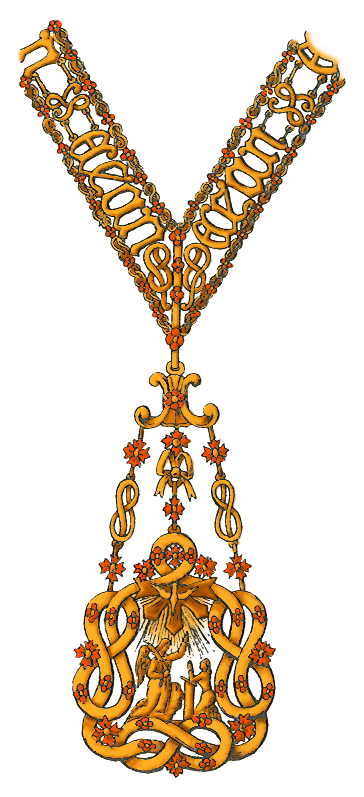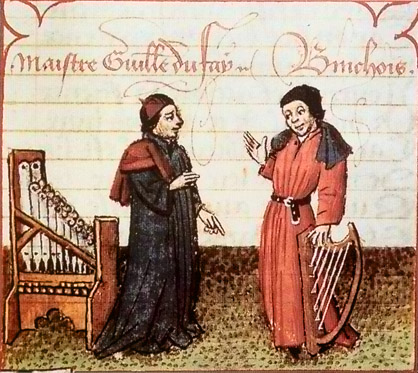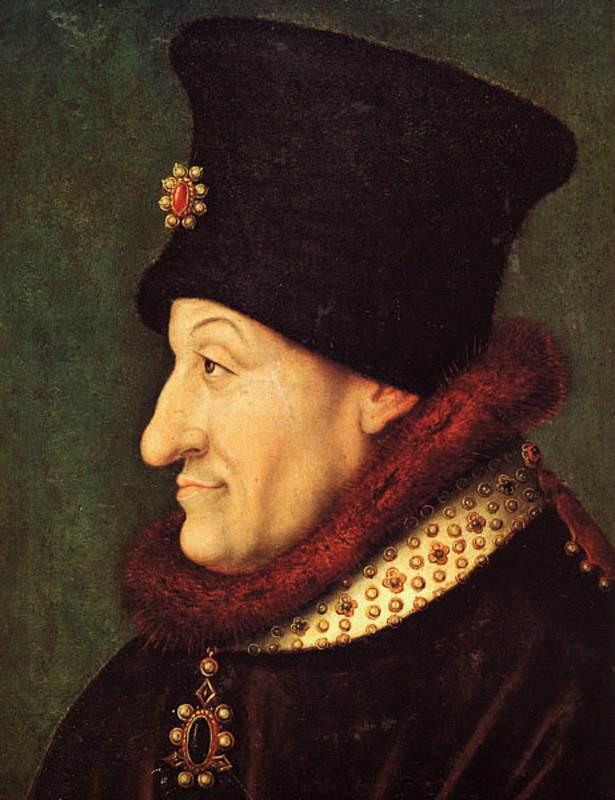|
Duke Philip The Good
Philip III (french: Philippe le Bon; nl, Filips de Goede; 31 July 1396 – 15 June 1467) was Duke of Burgundy from 1419 until his death. He was a member of a cadet line of the Valois dynasty, to which all 15th-century kings of France belonged. During his reign, the Burgundian State reached the apex of its prosperity and prestige, and became a leading centre of the arts. Philip is known historically for his administrative reforms, his patronage of Flemish artists such as van Eyck and Franco-Flemish composers such as Gilles Binchois, and perhaps most significantly the seizure of Joan of Arc, whom Philip ransomed to the English after his soldiers captured her, resulting in her trial and eventual execution. In political affairs, he alternated between alliances with the English and the French in an attempt to improve his dynasty's powerbase. Additionally, as ruler of Flanders, Brabant, Limburg, Artois, Hainaut, Holland, Luxembourg, Zeeland, Friesland and Namur, he pl ... [...More Info...] [...Related Items...] OR: [Wikipedia] [Google] [Baidu] |
Collar (Order Of Knighthood)
A collar also known as collar of an order is an ornate chain, often made of gold and enamel, and set with precious stones, which is worn about the neck as a symbol of membership in various chivalric orders. It is a particular form of the livery collar, the grandest form of the widespread phenomenon of livery in the Middle Ages and Early Modern Period. Orders which have several grades often reserve the collar for the highest grade (usually called the Grand Cross). The links of the chain are usually composed of symbols of the order, and the badge (also called "decoration", "cross" or "jewel") of the order normally hangs down in front. Sometimes the badge is referred to by what is depicted on it; for instance, the badge that hangs from the chain of the Order of the Garter is referred to as "the George". History A medieval tradition: the Order of the Collar (14th century) The first of the Orders of Knighthood were the military orders of crusaders who used red, green or black cr ... [...More Info...] [...Related Items...] OR: [Wikipedia] [Google] [Baidu] |
Anthony, Bastard Of Burgundy
Antoine de Bourgogne (1421 – 5 May 1504), known to his contemporaries as the Bastard of Burgundy or ''Le grand bâtard'' ("the Great Bastard"), was the natural son (and second child) of Philip III, Duke of Burgundy, and one of his mistresses, Jeanne de Presle. He was comte de La Roche (Ardenne), de Grandpré, de Sainte-Menehould et de Guînes, seigneur de Crèvecoeur, Beveren et Tournehem, and chevalier of the Golden Fleece. Life Born in 1421, possibly at Lizy in Picardy, he was brought up in the Burgundian court with his younger half-brother, the Count of Charolais, later Charles the Bold, last of the Valois Dukes of Burgundy, to whom he grew very close. Together with his older illegitimate half-brother Corneille, bastard of Burgundy (died 1452), he was the favourite amongst the many natural children of Philip the Good. In 1459, he married Marie de la Viesville by whom he had five children. Anthony fought for his father on several campaigns, from at least 1451 onwards ... [...More Info...] [...Related Items...] OR: [Wikipedia] [Google] [Baidu] |
Joan Of Arc
Joan of Arc (french: link=yes, Jeanne d'Arc, translit= �an daʁk} ; 1412 – 30 May 1431) is a patron saint of France, honored as a defender of the French nation for her role in the siege of Orléans and her insistence on the coronation of Charles VII of France during the Hundred Years' War. Stating that she was acting under divine guidance, she became a military leader who transcended gender roles and gained recognition as a savior of France. Joan was born to a propertied peasant family at Domrémy in northeast France. In 1428, she requested to be taken to Charles, later testifying that she was guided by visions from the archangel Michael, Saint Margaret, and Saint Catherine to help him save France from English domination. Convinced of her devotion and purity, Charles sent Joan, who was about seventeen years old, to the siege of Orléans as part of a relief army. She arrived at the city in April 1429, wielding her banner and bringing hope to the demoralized Frenc ... [...More Info...] [...Related Items...] OR: [Wikipedia] [Google] [Baidu] |
Gilles Binchois
Gilles de Bins dit Binchois (also Binchoys; – 20 September 1460) was a Franco-Flemish composer of early Renaissance music. A central figure of the Burgundian School, Binchois and his colleague Guillaume Du Fay were deeply influenced by the ''contenance angloise'' style of John Dunstaple. His efforts in consolidating a 'Burgundian tradition' would be important for the formation of the Franco-Flemish School. One of the three most famous composers of the early 15th century, Binchois is often ranked behind Du Fay and Dunstable by contemporary scholars, but his works were still widely cited, emulated and used as source material after his death. Described by the musicologist Anthony Pryer as a "supreme miniaturist", he generally avoided large scale works, and is most admired for his shorter secular chansons. Despite this, it is thought that considerably more of his sacred music survives than secular music, creating a 'paradoxical image' of the composer. Reflecting on his style, th ... [...More Info...] [...Related Items...] OR: [Wikipedia] [Google] [Baidu] |
Franco-Flemish School
The designation Franco-Flemish School, also called Netherlandish School, Burgundian School, Low Countries School, Flemish School, Dutch School, or Northern School, refers, somewhat imprecisely, to the style of polyphonic vocal music composition originating from France and from the Burgundian Netherlands in the 15th and 16th centuries as well as to the composers who wrote it. The spread of their technique, especially after the revolutionary development of printing, produced the first true international style since the unification of Gregorian chant in the 9th century. Franco-Flemish composers mainly wrote sacred music, primarily masses, motets, and hymns. Term and controversy Several generations of Renaissance composers from the region loosely known as the Low Countries (Imperial and French fiefs ruled in personal union by the House of Valois-Burgundy in the period from 1384 to 1482)—i.e. present-day Northern France, Belgium and the Southern Netherlands—are grouped under "Fran ... [...More Info...] [...Related Items...] OR: [Wikipedia] [Google] [Baidu] |
Jan Van Eyck
Jan van Eyck ( , ; – July 9, 1441) was a painter active in Bruges who was one of the early innovators of what became known as Early Netherlandish painting, and one of the most significant representatives of Early Northern Renaissance art. According to Vasari and other art historians including Ernst Gombrich, he invented oil painting, Gombrich, The Story of Art, page 240 though most now regard that claim as an oversimplification. The surviving records indicate that he was born around 1380 or 1390, most likely in Maaseik (then Maaseyck, hence his name), Limburg, which is located in present-day Belgium. He took employment in The Hague around 1422, when he was already a master painter with workshop assistants, and was employed as painter and ''valet de chambre'' to John III the Pitiless, ruler of the counties of Holland and Hainaut. After John's death in 1425, he was later appointed as court painter to Philip the Good, Duke of Burgundy, and worked in Lille before moving to B ... [...More Info...] [...Related Items...] OR: [Wikipedia] [Google] [Baidu] |
Burgundian State
The Burgundian StateB. Schnerb, ''L'État bourguignon'', 1999 (french: État bourguignon; nl, Bourgondische Rijk) is a concept coined by historians to describe the vast complex of territories that is also referred to as Valois Burgundy. It developed in the Late Middle Ages under the rule of the Dukes of Burgundy from the French House of Valois and was composed of both French and Imperial fiefs (ducal and comital Burgundy and the Burgundian Netherlands). That territorial construction outlasted the properly 'Burgundian' dynasty and the loss of the Duchy of Burgundy itself. As such, it must not be confused with that sole fief. It is regarded as one of the major powers in Europe of the 15th century and the early 16th century. The Dukes of Burgundy were among the wealthiest and the most powerful princes in Europe and were sometimes called "Grand Dukes of the West". Including the thriving regions of Flanders and Brabant, the Burgundian State was a major centre of trade and commerce ... [...More Info...] [...Related Items...] OR: [Wikipedia] [Google] [Baidu] |
Kings Of France
France was ruled by monarchs from the establishment of the Kingdom of West Francia in 843 until the end of the Second French Empire in 1870, with several interruptions. Classical French historiography usually regards Clovis I () as the first king of France, however historians today consider that such a kingdom did not begin until the establishment of West Francia. Titles The kings used the title "King of the Franks" ( la, Rex Francorum) until the late twelfth century; the first to adopt the title of "King of France" (Latin: ''Rex Franciae''; French: ''roi de France'') was Philip II in 1190 (r. 1180–1223), after which the title "King of the Franks" gradually lost ground. However, ''Francorum Rex'' continued to be sometimes used, for example by Louis XII in 1499, by Francis I in 1515, and by Henry II in about 1550; it was also used on coins up to the eighteenth century. During the brief period when the French Constitution of 1791 was in effect (1791–1792) and after t ... [...More Info...] [...Related Items...] OR: [Wikipedia] [Google] [Baidu] |
House Of Valois
The Capetian house of Valois ( , also , ) was a cadet branch of the Capetian dynasty. They succeeded the House of Capet (or "Direct Capetians") to the List of French monarchs, French throne, and were the royal house of France from 1328 to 1589. Junior members of the family founded cadet branches in House of Valois#Dukes of Orléans, Orléans, House of Valois-Anjou, Anjou, House of Valois-Burgundy, Burgundy, and Counts and dukes of Alençon, Alençon. The Valois descended from Charles, Count of Valois (1270–1325), the second surviving son of King Philip III of France (reigned 1270–1285). Their title to the throne was based on a precedent in 1316 (later retroactively attributed to the Merovingian dynasty, Merovingian Salic law) which excluded females (Joan II of Navarre), as well as male descendants through the wiktionary:distaff side#English, distaff side (Edward III of England), from the succession to the French throne. After holding the throne for several centuries the Va ... [...More Info...] [...Related Items...] OR: [Wikipedia] [Google] [Baidu] |
Margaret Of Bavaria
Margaret of Bavaria (1363 – 23 January 1424, Dijon) was Duchess of Burgundy by marriage to John the Fearless. She was the regent of the Burgundian Low Countries during the absence of her spouse in 1404–1419 and the regent in French Burgundy during the absence of her son in 1419–1423. She became most known for her successful defense of the Duchy of Burgundy against Count John IV of Armagnac in 1419. Life Margaret was the fifth child of Albert I, Duke of Bavaria, Count of Hainault, Holland, and Zeeland and Lord of Frisia, and Margaret of Brieg.Bayley, Francis, ''The Bailleuls of Flanders and the Bayleys of Willow Hall'', (Spottiswoode & Co.:London, 1881), 263. Marriage On 12 April 1385, at the Burgundian double wedding in Cambrai, she married John, Count of Nevers, the son and heir of Philip the Bold, Duke of Burgundy, and Margaret of Dampierre, Countess of Flanders, Artois and Burgundy;Richard Vaughan, ''John the Fearless: The Growth of Burgundian Power'', (The Boydell Pre ... [...More Info...] [...Related Items...] OR: [Wikipedia] [Google] [Baidu] |
House Of Valois-Burgundy
The House of Valois-Burgundy (french: Maison de Valois-Bourgogne, nl, Huis van Valois-Bourgondië), or the Younger House of Burgundy, was a noble French family deriving from the royal House of Valois. It is distinct from the Capetian House of Burgundy, descendants of King Robert II of France, though both houses stem from the Capetian dynasty. They ruled the Duchy of Burgundy from 1363 to 1482 and later came to rule vast lands including Artois, Flanders, Luxembourg, Hainault, the county palatine of Burgundy (Franche-Comté), and other lands through marriage, forming what is now known as the Burgundian State. The term "Valois Dukes of Burgundy" is employed to refer to the dynasty which began after King John II of France granted the French Duchy of Burgundy to his youngest son, Philip the Bold in 1363. During the Hundred Years' War, the dukes rivalled with their royal cousins uniting a great number of French and Imperial fiefs under their rule. However, their plans to establish an ... [...More Info...] [...Related Items...] OR: [Wikipedia] [Google] [Baidu] |
Philip Of Burgundy (bishop)
Philip of Burgundy (1464 in Brussels – 7 April 1524 in Wijk bij Duurstede) was Admiral of the Netherlands from 1498 to 1517 and bishop of Utrecht from 1517 to 1524. Philip was an illegitimate son of Duke Philip the Good. 1486 he was knighted and in 1491 he single-handedly killed an opponent. He was at the head of the Burgundian army in the Sticht and, as such, refused to bury his half-brother David of Burgundy, bishop of Utrecht, as long as the election of a Burgundian-favoured successor had not been arranged. He was appointed admiral in 1498 by Duke Philip the Fair and after an expedition to Rome in 1508 he settled in the castle Souburg on Walcheren. In a politically motivated move, Philip was appointed bishop of Utrecht by Duke Charles (later Emperor Charles V) to replace Frederick IV of Baden. When he made his entrance into Utrecht he had not received any kind of ordination; these were given to him in the following days. He led a luxurious life in the episcopal re ... [...More Info...] [...Related Items...] OR: [Wikipedia] [Google] [Baidu] |






